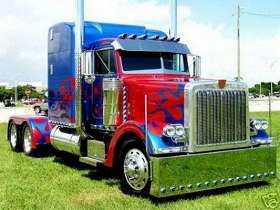Would More Permissive Split-sleeper-period Rules Allow Drivers To Get Better Rest?
Topic 13983 | Page 1

Divide my sleeper berth time as I saw fit.
I'm a grown-up.
If I'm handed all this responsibly, ergo I must accept all the blame for my mistakes, then I should also have the authority to make such decisions.
- mountain girl

Sleeper Berth:
The portion of the tractor behind the seats which acts as the "living space" for the driver. It generally contains a bed (or bunk beds), cabinets, lights, temperature control knobs, and 12 volt plugs for power.
Divide my sleeper berth time as I saw fit.
I'm a grown-up.
If I'm handed all this responsibly, ergo I must accept all the blame for my mistakes, then I should also have the authority to make such decisions.
- mountain girl
if only it worked like that.. =D
But I agree, should have the ability to use the split as we see fit....
Sleeper Berth:
The portion of the tractor behind the seats which acts as the "living space" for the driver. It generally contains a bed (or bunk beds), cabinets, lights, temperature control knobs, and 12 volt plugs for power.

I agree unconditionally with Mountaingirl!!!
There are times during the day that I know I will benefit from a three or four hour nap. But, that "nap time" will basically end my 14 hours. So, I take a cat nap and wake up feeling worse than when I stopped. So, I become completely unproductive.
On the flip side of the HOS Requirements, I have tried modifying my "split sleeper berth" times, and I have found that, sometimes, working four, five, or six hours and sleeping three or four hours afterwards actually leaves me feeling refreshed.
We are all adults out here, and I must say that I support the move toward modifying the HOS rules.
Sleeper Berth:
The portion of the tractor behind the seats which acts as the "living space" for the driver. It generally contains a bed (or bunk beds), cabinets, lights, temperature control knobs, and 12 volt plugs for power.
HOS:
Hours Of Service
HOS refers to the logbook hours of service regulations.I've said on record here in the forum for years that the 14 rule was a huge mistake. It took away all of the flexibility drivers used to have to run when it made sense to run and park it when it makes sense to park it.
In my opinion it would be nearly pointless to adjust the sleeper berth split without eliminating the 14 hour rule. The problem is that you still have to squeeze an 11 hour work day into a 14 hour period and people should not be forced to do as if we're robots working in a predictable environment. It's quite the opposite. Our mental alertness, physical readiness, weather conditions, traffic conditions, equipment functionality, and schedules change continuously.
Yet another side effect of the 14 hour rule was to force more trucks to be on the road at the same time and then looking for parking at the same time. I used to start at about 2:00 - 3:00 a.m. and get half a day's driving in before most people got up in the morning. I'd run my day anyway I saw fit and would try to get parked by 5:00 p.m. when there were still spaces open at the truck stops. But often times my day simply wasn't finished by 5:00 p.m. so I'd catch a nap somewhere along the way and extend my day into the evening.
With the 14 hour rule it's too risky to try to start your day at 2:00 a.m. if you have a morning delivery because you have no idea how long the unloading will take or what time and place your pickup will be that afternoon or what problems may creep up with schedule changes and breakdowns. If your 14 hour clock runs out at 4:00 p.m. you might put yourself out of hours before making your next pickup. It just doesn't make any sense to handcuff drivers that way.
And it isn't just about sleep by any means. It's about sitting out storms, waiting out rush hour traffic, sitting at customers waiting to be loaded or unloaded, getting repairs done, managing schedule changes, and taking care of other business we have to attend to as part of our jobs like paperwork and fueling and a hundred others.
The system we had for about a half a century worked perfectly. The same 70 hour rule but with 10 hours of driving, 8 hours of rest, a very flexible split sleeper berth option, and no 14 hour rule. The 34 hour reset is the one rule that was a huge improvement and made a lot of sense. That's the only thing I would add to the old rules we used to have and in my opinion that's an excellent system.
I don't care too much if it's 11 on and 10 off or 10 on and 8 off as long as you have a flexible sleeper berth option, the same 70 hour rule, and the 34 hour reset. That's the best system I can think of after 23 years in this industry and if they asked me today to design the new rules that's exactly what they would be.
Sleeper Berth:
The portion of the tractor behind the seats which acts as the "living space" for the driver. It generally contains a bed (or bunk beds), cabinets, lights, temperature control knobs, and 12 volt plugs for power.

It doesn't matter for me. I did the 8-2 and I got Sat for 10 hours. It was against company policy.

I was told not to use the 8/2 split but I don't get penelized if I do use it. I have used it a few times and I'll actually be using it tomorrow. I only use it for a day or 2 because I find it more tiring than a regular 10 hr break. But it does work pretty good for making up for sitting at a dock.

I was told not to use the 8/2 split but I don't get penelized if I do use it. I have used it a few times and I'll actually be using it tomorrow. I only use it for a day or 2 because I find it more tiring than a regular 10 hr break. But it does work pretty good for making up for sitting at a dock.
I use the 8/2 frequently, because it is quite beneficial. However, I have found that taking the 2 hour break before the 8 hour sleeper berth period works best for me.
Also, I agree with everything Brett wrote about the break periods we took before the "Pencil Pushers" decided we needed to turn into robots and work 14 hours per day after taking a "continuous" 10 hours off. I liked the old system.
Sleeper Berth:
The portion of the tractor behind the seats which acts as the "living space" for the driver. It generally contains a bed (or bunk beds), cabinets, lights, temperature control knobs, and 12 volt plugs for power.
I totally agree that more flexibility on split sleeper will not mean much; it's that damn 14 hour rule that screws things up. Ironically, the most distracted and tired driving that I have done has always been caused by forced adherence to HOS rules.
HOS:
Hours Of Service
HOS refers to the logbook hours of service regulations.
Agreed, Deb. Except I think the 70-hour rule also messes things up. Had a load that had to be delivered in the morning. I could have kept driving and then just woke up at around 4 or 5 AM near the customer to make delivery by 8. Instead I ran out of hours and had to park at 3 PM. Started up again at 1 AM. Definitely not keeping my circadians where they ought to be with that one, but stayed legal and made delivery on time.
At the cost of feeling more tired.
Something is clearly wrong with regulations intended to prevent tired driving when they cause tired driving.
New Reply:
New! Check out our help videos for a better understanding of our forum features

















Preview:








 TT On Facebook
TT On Facebook
The FMCSA released documents earlier this year showing it has plans for another study on split sleeper berth flexibility. Although, the research likely wouldn’t begin until later this year. What are your thoughts on the subject? Do you think that this flexibility will become a new rule for all drivers? How would you like to see it put in to effect?
Sleeper Berth:
The portion of the tractor behind the seats which acts as the "living space" for the driver. It generally contains a bed (or bunk beds), cabinets, lights, temperature control knobs, and 12 volt plugs for power.
CSA:
Compliance, Safety, Accountability (CSA)
The CSA is a Federal Motor Carrier Safety Administration (FMCSA) initiative to improve large truck and bus safety and ultimately reduce crashes, injuries, and fatalities that are related to commercial motor vehicle
FMCSA:
Federal Motor Carrier Safety Administration
The FMCSA was established within the Department of Transportation on January 1, 2000. Their primary mission is to prevent commercial motor vehicle-related fatalities and injuries.
What Does The FMCSA Do?
Dm:
Dispatcher, Fleet Manager, Driver Manager
The primary person a driver communicates with at his/her company. A dispatcher can play many roles, depending on the company's structure. Dispatchers may assign freight, file requests for home time, relay messages between the driver and management, inform customer service of any delays, change appointment times, and report information to the load planners.Fm:
Dispatcher, Fleet Manager, Driver Manager
The primary person a driver communicates with at his/her company. A dispatcher can play many roles, depending on the company's structure. Dispatchers may assign freight, file requests for home time, relay messages between the driver and management, inform customer service of any delays, change appointment times, and report information to the load planners.OWI:
Operating While Intoxicated